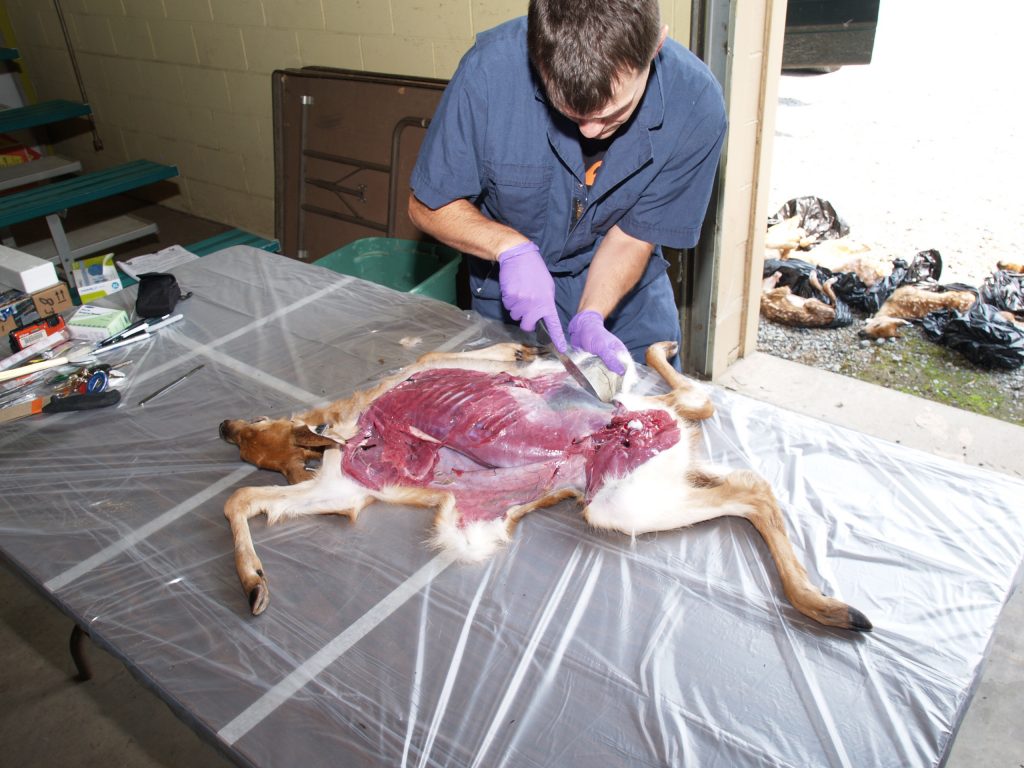Fawn capture is over and we have started processing data from mortalities to classify cause of death. Last week I shared with you some insights into the necropsy process.
And I provided a short quiz to test your knowledge. By Tuesday afternoon, 350 people had taken the quiz. [If you want to take the quiz and then check back for the answers, then click here].
Here is a review of the questions and our answers. The quiz began with a series of True/False questions.
1. You need the whole carcass to determine cause of death. False. Many times we obtain only parts of the carcass when the animal is predated so it is not necessary to have the whole carcass to determine cause of death. Eight-five percent of respondents got this one correct.
2. Necropsy is the only tool needed to determine cause of death. False. Everyone got this one correct. The necropsy, field notes, and DNA tests should all be taken into account – Jeannine made this point in a previous post.
3. A deer’s gall bladder is located near the liver. False. Deer don’t have a gall bladder! Eighty percent got this wrong, but if you were an avid reader you would have known it was sort of a trick question because we have written about why deer lack a gall bladder (and how it was taken away from them by the antelope).
4. Seeing pooled blood during a necropsy always means a predator was responsible. False. Other physical trauma (e.g., a vehicle collision) can result in pooled blood. Ninety percent answered this question correctly.
5. Cases of predation are always accompanied with signs of trauma and wounds. False. This question might have been worded better, but 51% of you answered the question correctly. We have recovered deer with little to no evidence of cause of mortality until we conducted a necropsy. An almost perfect example occurred last year when we found a dead fawn that upon necropsy we determined it was killed by a dog.
6. Cases of predation are easily identifiable in the field. False. Sometimes there is little evidence upon which to determine cause of death, except that a predation event occurred (e.g., only a blood-stained collar is recovered). Eighty-eight percent answered correctly.
7. What tissues are not affected by parasites, worms, or disease in white-tailed deer? All tissues can be affected. Ninety-three percent answered correctly!
8. Which one of these words (autolysis and necrosis) is another way of saying “rotting tissues”? Autolysis. Seventy-nine percent answered correctly.
9. At the scene of the crime you find a deceased fawn partially hidden in a den. Which predator do you begin to suspect? We considered either red fox or coyote the best answers, of which 55% of you selected one of these two. Bears are not using dens when fawns are being born (26% chose this answer). Also, bobcats do use dens occasionally (tree cavity or rock – and even an abandoned beaver lodge!) but are more likely to give birth on the ground in thick cover. But also keep in mind just because a carcass is located at a den does not mean it was killed by a predator.
10. During necropsy you notice the trachea has been crushed. Which predator do you begin to suspect? Bobcat is probably the best answer, but coyotes oftentimes crush the trachea as well. However, you can’t rule out any predator. Fifty-eight percent selected bobcat, 24% selected coyote, 17% selected bear, and <1% selected red fox.
We hope you had a great Fourth of July weekend and had fun with the quiz (and maybe even learned something). Thanks for participating!
-Tess Gingery
M.S. graduate student
Department of Ecosystem Science and Management
Pennsylvania Cooperative Fish and Wildlife Research Unit
